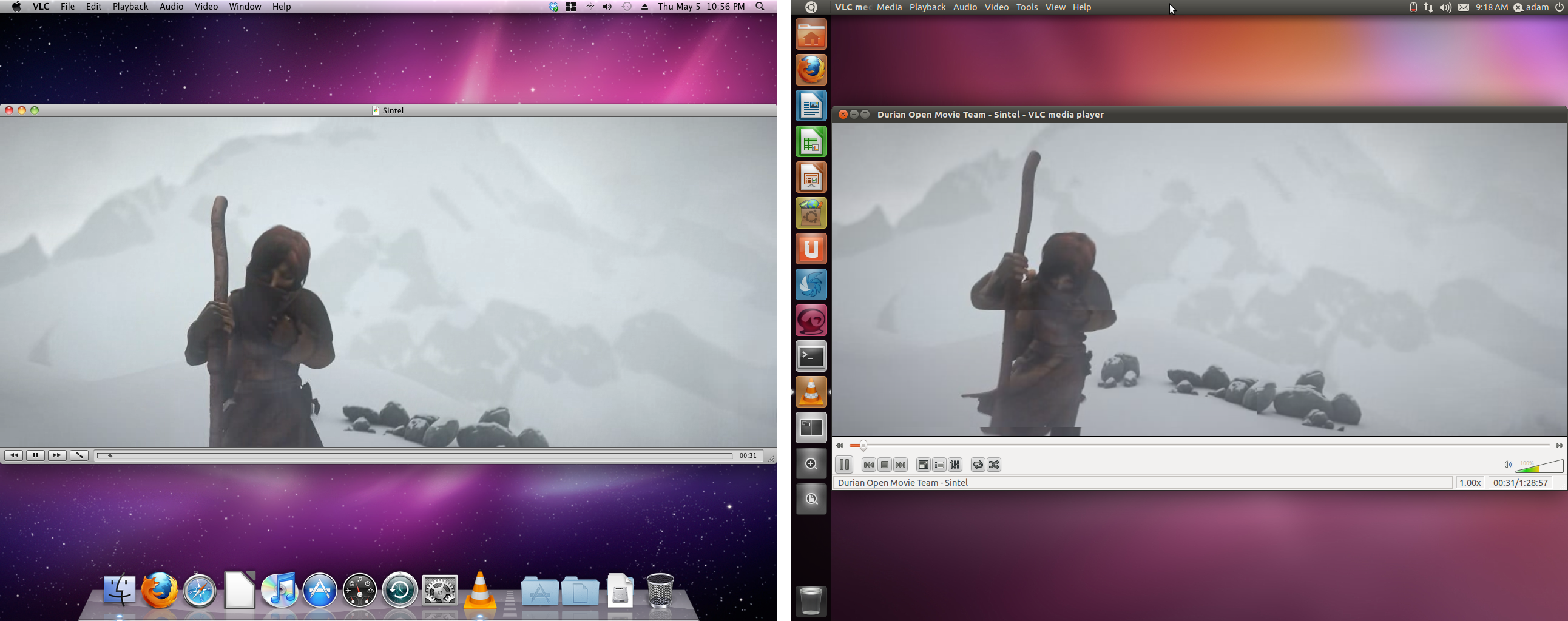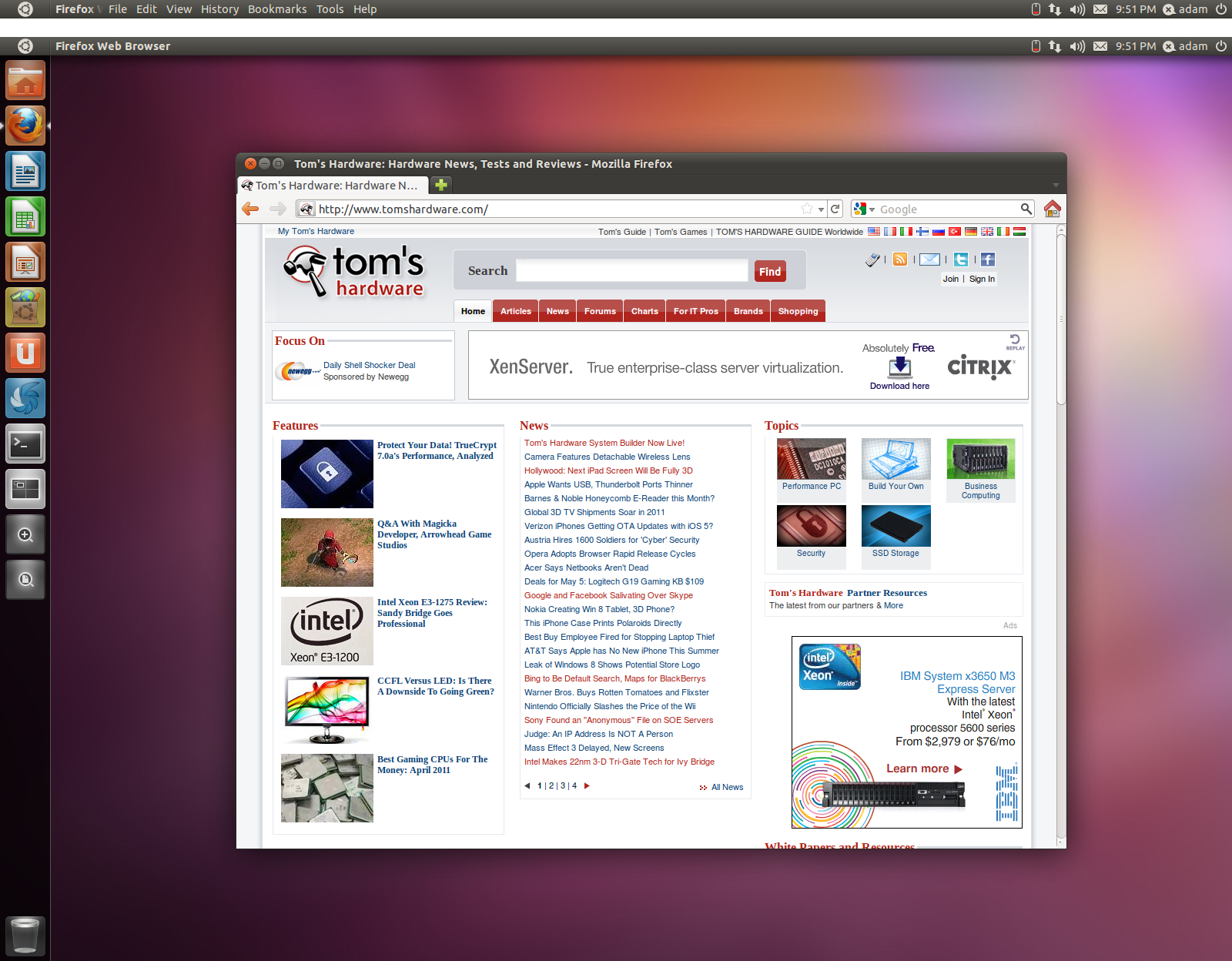Ubuntu 11.04 (Natty Narwhal), Reviewed In Depth
Ubuntu 11.04 (Natty Narwhal) has arrived, and we have the scoop on everything you need to know about Canonical's latest Linux, along with the usual review and benchmarks. Is this the change we've been waiting for, or is the Natty Narwhal a fail whale?
The Panel
While the Unity Panel may appear similar to the upper panel in previous versions of Ubuntu, it functions very differently. First and foremost, the Unity Panel cannot be customized. Quick launchers and applets cannot be added, and the position of Panel elements are locked in place. In fact, there's no more right-click functionality, period. The bulk of the Panel (where most launchers and applets used to go) is reserved for a Mac OS-style global menu. The combined Applications/Places/System menu is replaced by the Ubuntu button, which activates Dash.
The Panel in Unity is composed of three main areas: indicators, global menu, and Dash. Let's take a look at how each element of the new Panel functions, starting with the familiar-looking indicators.
Indicators
At first glance, the indicators on the far-right end of the Panel look largely unchanged from Ubuntu 10.10. But upon further comparison, the changes are significant. Unity's effort to save screen real estate and push uniformity also hits the indicators. The icons are now closer together than in 11.04 Classic and previous versions of Ubuntu. The WiFi and battery life icons are slightly larger, and are equal in size to the other indicator icons.
The sequence of the indicators remains the same. From right to left: login/logout, user messaging/social status, time/date/calendar, mail/message notifier, volume controls, connectivity status, battery life, Bluetooth, and application-specific indicator controls. As usual, clicking an indicator icon produces a drop-down menu of related options. The only two differences we found in the Ubuntu 11.04 indicator menus are the addition of System Settings to the end of the login/logout indicator menu (explained earlier), and the omission of a weather option in the time/date/calendar indicator.
Under the surface, the indicators get more interesting. In Natty Narwhal, indicators can now passively convey information by changing color. While colored indicators aren't anything new, they now have uniform and clearly-defined meanings. The definitions of these color-coded indicators are displayed in the table below, in descending order, from most to least urgent:
| Color | Definition |
|---|---|
| Red | Critical Issue/Action |
| Orange | Critical Warning |
| Blue | Contains Information |
| Green | OK/Approved |
| Grey/Theme Default | Neutral/No Status |
Both red and orange indicators usually refer to system-level events, while blue and green mainly concern applications. When indicators turn red, a critical issue is present. This usually means that some form of action is needed from the user. For example, the login/logout indicator may turn red because a restart is required to complete a major kernel update. Indicators turn orange for critical warnings. Unlike critical issues, critical warnings do not require action from the user. Indicators that turn blue contain new, non-critical information. The mail/messaging indicator may turn blue if there are new items in one of the attached applications or services. Green indicators mean something is OK or approved. When indicators have nothing to report, they remain grey, or they use the theme default color if you changed themes.
Get Tom's Hardware's best news and in-depth reviews, straight to your inbox.
Global Menu
If you haven't used a Mac operating system in the last quarter-century, the global menu won't be a familiar concept. Essentially, the global menu is a menu bar in a different location. Usually, the menu bar is located in-between the window title bar and the application toolbars.
The other way to display the File, Edit, View, and Help options is in a global menu. In operating systems that employ a global menu, the menu bar of each application is not housed within the application's window. Instead, the operating system must provide an ever-present, dedicated menu bar. As in Mac OS X, the upper Panel in Ubuntu 11.04 houses the menu bar items of the currently-selected application.
In contrast to OS X, the global menu in Unity behaves differently depending on whether or not there is an active application present, and if that application is windowed or maximized.
No Active Application
When there are no active applications present (the desktop is in the foreground), the area of the Panel between Dash and the indicators is empty. Hovering the mouse cursor over the middle section of the Panel brings up the desktop global menu.
The File, Edit, and View menus hold all the right-click functions available to the desktop and objects on the desktop. The Places menu contains quick links to folders and connected devices, much like the Places section of the old Applications/Places/System menu in previous versions of Ubuntu. While there is an option to Add Bookmark, it doesn't appear to work. Additional items can still be added to the Places menu by dragging them to the Places side pane in the Nautilus file manager, just like in previous versions of Ubuntu.
Windowed Active Application
The name of the currently-active application is located in the Panel just to the right of Dash when it's windowed. The name of the file, Web page, or folder being viewed in the active application appears in the window title bar just to the right of the window controls. Hovering the mouse cursor over the middle area of the Panel fades the application's name (past the first seven characters) to reveal the global menu bar items.
Maximized Active Application
When an application is maximized, the window title bar combines with the Panel. Window controls now appear to the right of Dash, followed by the name of the file/page/folder being viewed in the active application. Hovering the mouse to the middle area of the Panel replaces the file/page/folder name with the global menu bar items.






